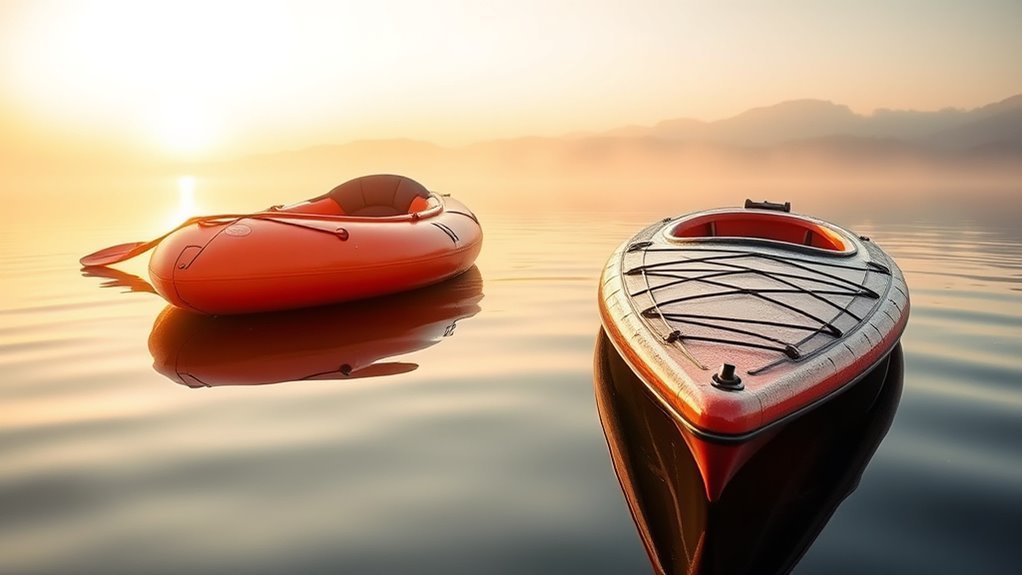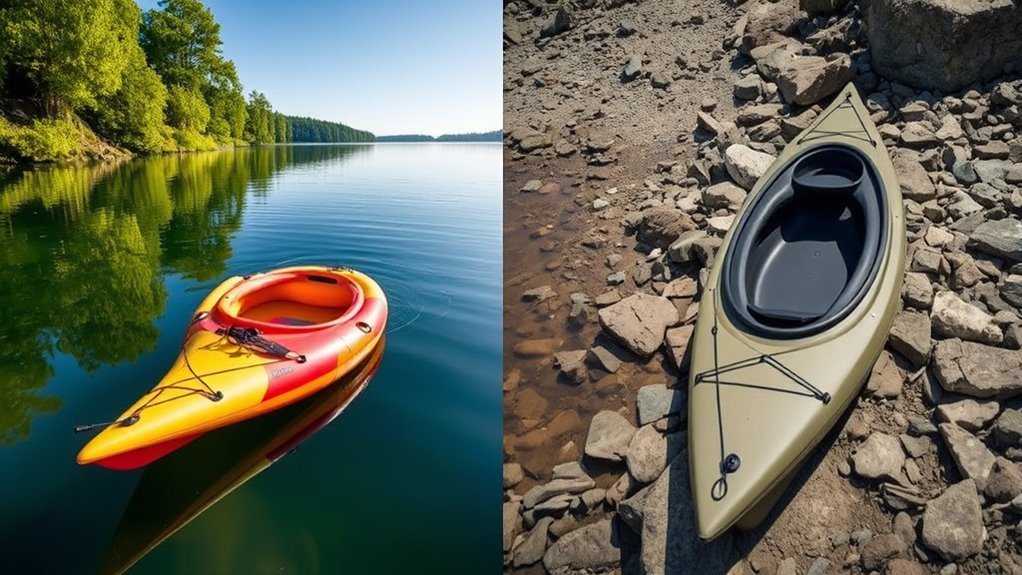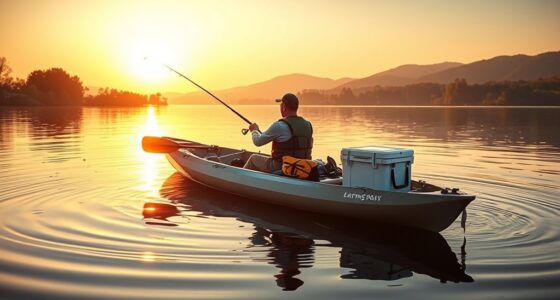When choosing between inflatable and hard-shell kayaks, consider your needs. Inflatable kayaks are portable, easy to store, and require minimal maintenance, making them great for casual paddlers. However, they’re less durable and stable compared to hard-shell kayaks, which offer better performance in rough waters and are more suitable for frequent use. Think about your paddling style and conditions, and you’ll find the perfect fit. There’s more to explore regarding each type’s benefits and drawbacks.
Key Takeaways
- Inflatable kayaks are portable and easy to store, ideal for those with limited space, while hard-shell kayaks require more storage and transport considerations.
- Hard-shell kayaks offer greater durability and stability, making them suitable for rough waters, whereas inflatables are better for casual use.
- Inflatable kayaks are lightweight and easy to carry, eliminating the need for special transport equipment compared to the heavier hard-shell models.
- Maintenance for inflatables is minimal, requiring only rinsing and occasional patching, while hard-shells need regular upkeep to prevent damage.
- Frequent paddlers may prefer hard-shell kayaks for longevity, while beginners or occasional users might find inflatables more cost-effective and user-friendly.

When you’re deciding between inflatable and hard-shell kayaks, it helps to contemplate your specific needs and preferences. Each type has its unique advantages and disadvantages that can considerably impact your paddling experience. For instance, if you’re short on space, inflatable kayaks might be your best bet due to their portable storage capabilities. They can easily deflate and pack away into a manageable size, making them ideal for apartment dwellers or those who travel frequently. You can toss one in the trunk of your car or store it in a closet without taking up much room.
When choosing between inflatable and hard-shell kayaks, consider your space and storage needs for the best experience.
On the other hand, hard-shell kayaks typically offer more durability and stability on the water. If you’re planning to tackle rougher waters, a solid construction could provide you with the confidence you need. However, they require more storage space, and transporting them can be a hassle without a roof rack or trailer. You’ll have to consider your vehicle’s capacity and your own physical ability to lift and load a hard-shell kayak.
Maintenance ease is another factor to weigh. Inflatable kayaks generally require less upkeep. A quick rinse after use is usually enough, and any minor punctures can often be repaired with a simple patch kit. They are designed for casual use, so if you’re not looking to invest too much time in maintenance, they might suit you perfectly. In contrast, hard-shell kayaks can demand a bit more attention. Scratches and dings need to be addressed quickly to avoid any long-term damage. You may need to invest in specialized cleaning supplies to keep it in pristine condition.
Consider your paddling frequency as well. If you plan to kayak often, a hard-shell might be worth the investment due to its longevity and performance. However, if you’re just starting out or only plan to paddle occasionally, an inflatable kayak could provide a more cost-effective and user-friendly option. Ultimately, it’s about aligning your choice with how you intend to use the kayak. Reflect on the type of water you’ll navigate, how much space you have for storage, and how much time you’re willing to dedicate to maintenance. Your decision will shape your kayaking adventures for years to come, so choose wisely! Additionally, appreciating the unique bond formed during family kayaking trips can enhance your overall experience together.
Frequently Asked Questions
How Do I Store My Kayak During the Winter?
To store your kayak during the winter, choose a dry, temperature-controlled space. Use storage solutions like padded racks or wall hooks to keep it elevated and avoid contact with the ground. Clean it thoroughly and dry it to prevent mold. For winterization tips, remove any accessories and check for damage. If it’s inflatable, deflate it carefully, and store it in a cool, dark place to maintain its condition.
Can I Repair My Inflatable Kayak at Home?
Yes, you can repair your inflatable kayak at home! DIY repairs are quite feasible, especially if you have patch kits designed for inflatable materials. First, locate the puncture or tear, clean the area, and apply the patch according to the kit’s instructions. Make sure to let it cure properly before using the kayak again. With the right tools and a little patience, you can get your kayak back in shape for your next adventure!
What Safety Gear Is Essential for Kayaking?
When you set out on your kayaking adventure, think of your safety gear as your trusty compass guiding you through uncharted waters. Essential safety gear includes a personal flotation device (PFD), a whistle, and a first-aid kit. Don’t forget about a helmet for rough waters and a dry bag for valuables. Following these kayaking safety tips ensures you stay prepared, allowing you to enjoy the beauty around you without worry. Stay safe and paddle on!
Are There Age Restrictions for Kayaking?
There aren’t universal age restrictions for kayaking, but many places recommend that children under 12 be accompanied by an adult. If you’re a beginner, consider if the child has the maturity and skills to handle a kayak safely. Always check local regulations, as they may vary. Some rentals or guided tours might have specific age requirements, so it’s best to inquire beforehand to guarantee a smooth experience for everyone involved.
How Do I Choose the Right Paddle for My Kayak?
Choosing the right paddle for your kayak is like finding the perfect dance partner; it should feel right in your hands. Start by considering paddle material; lightweight options like carbon fiber allow for easier maneuverability. Next, focus on paddle size—generally, longer paddles suit wider kayaks, while shorter ones work for narrower designs. Test a few options to see what feels best for your paddling style and comfort. You’ll glide through the water effortlessly!
Conclusion
In the end, choosing between inflatable and hard-shell kayaks boils down to your personal preferences and needs. Are you seeking portability and ease of storage, or do you crave stability and performance? Just like a river’s current, your choice will shape your adventures on the water. No matter which you pick, both types can lead to unforgettable experiences, reminding you that the journey is just as important as the destination. So, which path will you paddle down?










